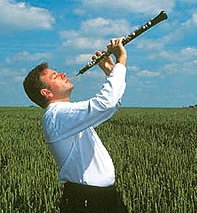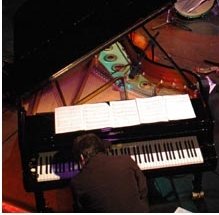Leach_Xantippe_sRebuke_pg12[1].pdf
From Sequenza21 regular Mary Jane Leach:
Xantippe’s Rebuke, for oboe soloist and eight taped oboes, is an intense study in sound that tickles your ears. It will be performed on the Sequenza 21 Concert by Matt Sullivan. I’ve written about my approach to writing it, which I hope you will find interesting.
My work has primarily been concerned with exploring sound phenomena – combination, difference and interference tones. I work very carefully with the specific sound properties of each instrument that I write for, qualities that change from instrument to instrument.
Initially this was done in rather direct, almost linear, ways, writing pieces for multiples of instruments, or similar instruments, that I could perform myself, taking advantage of 8-track tape machines to make the pieces. At first I wrote only for instruments that I could play myself (clarinet, bass clarinet, voice).
Two developments that helped me to expand my approach were working with vocal ensembles that could perform my multi-track vocal works, and working with music software on the computer. Using vocal groups freed up the music, releasing it from the constraints of click tracks and the rigidity (both of tempo and dynamics) that resulted from making pieces on tape, opening up the sound. By using the computer and midi playback, I was able to start writing for instruments that I didn’t play. Midi playback enabled me to compose studies of the instruments and to hear the resulting sound phenomena of these instruments without having to go through the laborious task of making multi-track study tapes of the instruments (and dealing with the problems of machines with slightly different speeds).
At first I had to tweak the sounds available to get the right overtone distribution, but eventually I started working with the Proteus instrumental sounds, which, if not perfect, at least are pretty accurate in their overtone profiles.
Writing for solo instruments is a challenge. One of the main problems, at least for me, is that I’m just not interested in even listening to a solo piece (with a few notable exceptions, but those pieces are generally for string instruments that can play multiple stops).
A way around that for me is to write a taped part that a performer plays along with in concert. At first I tried a music minus one approach, but quickly realized that that just didn’t work. If the taped parts and the live parts need to match in sound quality, then the live part is never going to match the taped sound, so the live part will either stick out like a sore thumb or will be masked by the taped parts. I tried a music plus one approach, in which the entire piece is on tape and then I augmented it in performance, but that would be too boring for anyone else to perform. I wanted to write pieces for soloists that they would want to perform and that would give them some freedom.
So I finally decided to write a solo piece that would be played with a taped part of multiples of that instrument, a sort of concerto. The taped parts would be equal and interdependent, while the solo part would be a “real” solo, in which the performer has some flexibility.
Xantippe’s Rebuke works very carefully with the unique sound of the oboe. (The partials of the oboe are so intense, that I had to stop using headphones while I worked on the piece.) The taped oboes are written to exploit its sound properties. I started with unison pitches that created the richest sound and built the piece from there. Most of the subsequent pitches and phrases that I wrote sounded acoustically before I notated them later on in the piece, and these in turn created other sound phenomena. So, in effect, the nature of the oboe and its natural sound properties determined the direction of the piece. Panning affects what happens sonically, and I worked with that. I also used panning to give cues to the performer (in addition to pitch cues), as an aid to orientation.
The solo part starts off by playing notes that are being created, but not notated or played, on the tape (sound phenomena), continuing on to play a melody that “floats” above the taped oboes.works very carefully with the unique sound of the oboe. (The partials of the oboe are so intense, that I had to stop using headphones while I worked on the piece.) The taped oboes are written to exploit its sound properties. I started with unison pitches that created the richest sound and built the piece from there. Most of the subsequent pitches and phrases that I wrote sounded acoustically before I notated them later on in the piece, and these in turn created other sound phenomena. So, in effect, the nature of the oboe and its natural sound properties determined the direction of the piece. Panning affects what happens sonically, and I worked with that. I also used panning to give cues to the performer (in addition to pitch cues), as an aid to orientation. The solo part starts off by playing notes that are being created, but not notated or played, on the tape (sound phenomena), continuing on to play a melody that “floats” above the taped oboes.
When it came time to name this piece, I was having a difficult time. I went through old notebooks to find an inspiration. Years ago, I had jotted down “Xantippe,” because I liked the name, and I decided that I’d like to use it. One, I thought it would be great to have a piece that began with “X” and two, I thought Xantippe had gotten a bum rap through the centuries. She was the wife of Socrates, and was known for being a scold. But since Socrates didn’t work and hung out all day talking with his followers while she ran the household, I think that characterization is unfair. I might have done more than dump the contents of the chamber pot on his head. This piece is Xantippe’s chance to speak up on her behalf.
 This past Sunday 37,936 people ran 26.22 miles through parts of all five boroughs of New York City from Staten Island to Central Park, through parts of all five boroughs. The marathon has taken place on the first Sunday of November every year since 1970, and this year Jelena Prokopcuka won the women’s division with a time of 2:25:05, M. Gomes dos Santos won the men’s division clocking in at 2:09:58, and the wheelchair divisions male and female winners were Stephen Kiogora (2:10:06) and Paul Tergat (2:10:10).
This past Sunday 37,936 people ran 26.22 miles through parts of all five boroughs of New York City from Staten Island to Central Park, through parts of all five boroughs. The marathon has taken place on the first Sunday of November every year since 1970, and this year Jelena Prokopcuka won the women’s division with a time of 2:25:05, M. Gomes dos Santos won the men’s division clocking in at 2:09:58, and the wheelchair divisions male and female winners were Stephen Kiogora (2:10:06) and Paul Tergat (2:10:10).
 Tomorrow (Nov 6) soloist Nicholas Daniel (left) and the Britten Sinfonia give
Tomorrow (Nov 6) soloist Nicholas Daniel (left) and the Britten Sinfonia give  You don’t need to be a
You don’t need to be a 
